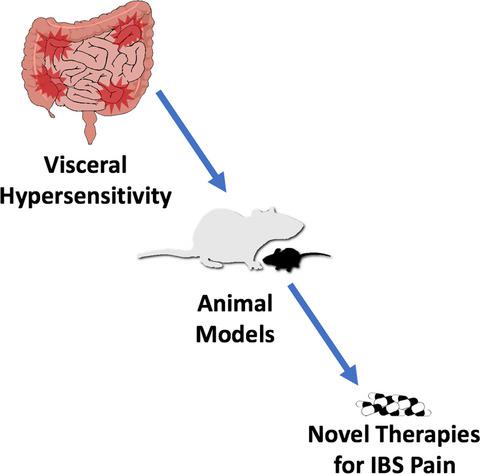当前位置:
X-MOL 学术
›
Neurogastroenterol. Motil.
›
论文详情
Our official English website, www.x-mol.net, welcomes your
feedback! (Note: you will need to create a separate account there.)
Critical evaluation of animal models of visceral pain for therapeutics development: A focus on irritable bowel syndrome.
Neurogastroenterology & Motility ( IF 3.5 ) Pub Date : 2019-12-13 , DOI: 10.1111/nmo.13776 Anthony C Johnson 1, 2, 3, 4 , Adam D Farmer 5, 6 , Timothy J Ness 7 , Beverley Greenwood-Van Meerveld 1, 2, 4
Neurogastroenterology & Motility ( IF 3.5 ) Pub Date : 2019-12-13 , DOI: 10.1111/nmo.13776 Anthony C Johnson 1, 2, 3, 4 , Adam D Farmer 5, 6 , Timothy J Ness 7 , Beverley Greenwood-Van Meerveld 1, 2, 4
Affiliation

|
The classification of chronic visceral pain is complex, resulting from persistent inflammation, vascular (ischemic) mechanisms, cancer, obstruction or distension, traction or compression, and combined mechanisms, as well as unexplained functional mechanisms. Despite the prevalence, treatment options for chronic visceral pain are limited. Given this unmet clinical need, the development of novel analgesic agents, with defined targets derived from preclinical studies, is urgently needed. While various animal models have played an important role in our understanding of visceral pain, our knowledge is far from complete. Due to the complexity of visceral pain, this document will focus on chronic abdominal pain, which is the major complaint in patients with disorders of the gut-brain interaction, also referred to as functional gastrointestinal disorders, such as irritable bowel syndrome (IBS). Models for IBS are faced with challenges including a complex clinical phenotype, which is comorbid with other conditions including anxiety, depression, painful bladder syndrome, and chronic pelvic pain. Based upon the multifactorial nature of IBS with complicated interactions between biological, psychological, and sociological variables, no single experimental model recapitulates all the symptoms of IBS. This position paper will contextualize chronic visceral pain using the example of IBS and focus on its pathophysiology while providing a critical review of current animal models that are most relevant, robust, and reliable in which to screen promising therapeutics to alleviate visceral pain and delineate the gaps and challenges with these models. We will also highlight, prioritize, and come to a consensus on the models with the highest face/construct validity.
中文翻译:

对内脏疼痛动物模型进行治疗开发的批判性评估:重点关注肠易激综合征。
慢性内脏痛的分类很复杂,由持续性炎症、血管(缺血)机制、癌症、阻塞或扩张、牵引或压迫以及组合机制以及无法解释的功能机制引起。尽管慢性内脏疼痛很常见,但治疗选择仍然有限。鉴于这种未满足的临床需求,迫切需要开发具有来自临床前研究的明确目标的新型镇痛剂。虽然各种动物模型在我们理解内脏疼痛方面发挥了重要作用,但我们的知识还远远不够完整。由于内脏疼痛的复杂性,本文将重点关注慢性腹痛,这是肠-脑相互作用障碍患者的主要主诉,也称为功能性胃肠道疾病,例如肠易激综合征 (IBS)。 IBS 模型面临着复杂的临床表型等挑战,该表型与焦虑、抑郁、膀胱疼痛综合征和慢性盆腔疼痛等其他疾病共存。基于 IBS 的多因素性质以及生物、心理和社会学变量之间复杂的相互作用,没有单一的实验模型能够概括 IBS 的所有症状。本立场文件将以肠易激综合症为例,将慢性内脏疼痛置于背景下,重点关注其病理生理学,同时对当前最相关、稳健和可靠的动物模型进行严格审查,以筛选有前途的治疗方法,以减轻内脏疼痛并划定差距。以及这些模型面临的挑战。我们还将突出显示、优先考虑具有最高表面/结构有效性的模型,并达成共识。
更新日期:2020-03-26
中文翻译:

对内脏疼痛动物模型进行治疗开发的批判性评估:重点关注肠易激综合征。
慢性内脏痛的分类很复杂,由持续性炎症、血管(缺血)机制、癌症、阻塞或扩张、牵引或压迫以及组合机制以及无法解释的功能机制引起。尽管慢性内脏疼痛很常见,但治疗选择仍然有限。鉴于这种未满足的临床需求,迫切需要开发具有来自临床前研究的明确目标的新型镇痛剂。虽然各种动物模型在我们理解内脏疼痛方面发挥了重要作用,但我们的知识还远远不够完整。由于内脏疼痛的复杂性,本文将重点关注慢性腹痛,这是肠-脑相互作用障碍患者的主要主诉,也称为功能性胃肠道疾病,例如肠易激综合征 (IBS)。 IBS 模型面临着复杂的临床表型等挑战,该表型与焦虑、抑郁、膀胱疼痛综合征和慢性盆腔疼痛等其他疾病共存。基于 IBS 的多因素性质以及生物、心理和社会学变量之间复杂的相互作用,没有单一的实验模型能够概括 IBS 的所有症状。本立场文件将以肠易激综合症为例,将慢性内脏疼痛置于背景下,重点关注其病理生理学,同时对当前最相关、稳健和可靠的动物模型进行严格审查,以筛选有前途的治疗方法,以减轻内脏疼痛并划定差距。以及这些模型面临的挑战。我们还将突出显示、优先考虑具有最高表面/结构有效性的模型,并达成共识。































 京公网安备 11010802027423号
京公网安备 11010802027423号